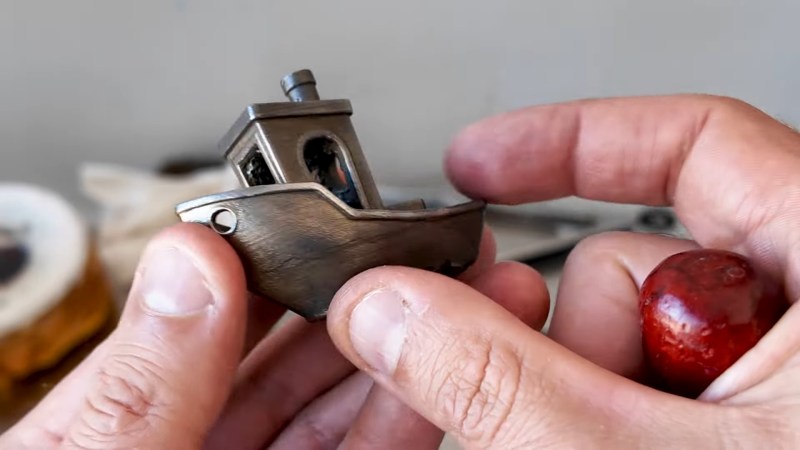As a test artifact, 3DBenchy does a pretty good job of making sure your 3D printer is up to scratch. As an exemplar of naval architecture, though — well, let’s just say that if it weren’t for the trapped air in the infilled areas, most Benchy prints wouldn’t float at all. About the only way to make Benchy less seaworthy would be to make it out of cast iron. Challenge accepted.
We’ve grown accustomed to seeing [Denny] over at “Shake the Future” on YouTube using his microwave-powered kilns to cast all sorts of metal, but this time he puts his skill and experience to melting iron. For those not in the know, he uses standard consumer-grade microwave ovens to heat kilns made from ceramic fiber and lots of Kapton tape, which hold silicon carbide crucibles that get really, really hot under the RF onslaught. It works surprisingly well, especially considering he does it all on an apartment balcony.
For this casting job, he printed a Benchy model from PLA and made a casting mold from finely ground silicon carbide blasting medium mixed with a little sodium silicate, or water glass. His raw material was a busted-up barbell weight, which melted remarkably well in the kiln. The first pour appeared to go well, but the metal didn’t quite make it all the way to the tip of Benchy’s funnel. Round two was a little more exciting, with a cracked crucible and spilled molten metal. The third time was a charm, though, with a nice pour and complete mold filling thanks to the vibrations of a reciprocating saw.
After a little fettling and a saltwater bath to achieve the appropriate patina, [Denny] built a neat little Benchy tableau using microwave-melted blue glass as a stand-in for water. It highlights the versatility of his method, which really seems like a game-changer for anyone who wants to get into home forging without the overhead of a proper propane or oil-fired furnace.
















A “forge” heats metal for forging, the process of deforming metal which has been heated until plastic.
Melting and casting metal is done in a “foundry”.
Both involve hot metal, but that’s all they have in common.
But of course, “Who’s to be the master? You or the word.” – Humpty Dumpty
👍
Yes, the difference is important as forging controls the “flow lines” of the crystals/grain in the metal in a way that has a significant effect on its mechanical properties whereas a casting from a foundry is relatively homogeneous, give or take cooling rate differences across the part. There are some good old school videos on YT about this topic.
How much does it cost to use a microwave to melt cast iron? We pay 33cents/kWH here in Commiefornia.
According to his time estimates, that would be $0.14. That’s definitely cheaper than the propane my foundry would take to melt this much cast iron, by an order of magnitude.
Fettling
https://en.wikipedia.org/wiki/Casting#Fettling
Raw castings often contain irregularities caused by seams and imperfections in the molds, as well as access ports for pouring material into the molds. The process of cutting, grinding, shaving or sanding away these unwanted bits is called “fettling” in UK english. In modern times robotic processes have been developed to perform some of the more repetitive parts of the fettling process, but historically fettlers carried out this arduous work manually, and often in conditions dangerous to their health. Fettling can add significantly to the cost of the resulting product, and designers of molds seek to minimize it through the shape of the mold, the material being cast, and sometimes by including decorative elements.
Galoots (as they call themselves) i.e. collectors of old woodworking tools, use the word “fettling” to describe the drawn out process of getting a hand plane adjusted properly.